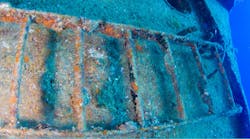Rust is a common problem on bridges, cars, and other metal structures, but new research shows that when it’s combined with saltwater, it can also be a source of electricity. New research conducted by chemists at Caltech and Northwestern University shows that thin films of rust (iron oxide) can generate electricity when saltwater flows over them. These films represent an entirely new way of generating electricity and could be used to develop new forms of sustainable power production.
Interactions between metal compounds and saltwater often generate electricity, but this is usually the result of a chemical reaction in which one or more compounds are converted to new compounds. These reactions are like those at work inside batteries.
In contrast, the new phenomenon discovered by Tom Miller, a chemistry professor at Caltech, and Franz Geiger, a chemistry professor at Northwestern, does not involve chemical reactions. Instead it converts the kinetic energy of flowing saltwater into electricity.
The phenomenon, known as the electrokinetic effect, has been observed before in thin films of graphene and is about 30% efficient at converting kinetic energy into electricity. For reference, the best solar panels are about 20% efficient.
“A similar effect has been seen in some other materials,” Miller says. “For example, you can drag a drop of saltwater across graphene and see some electricity generated.”
However, it is difficult to fabricate graphene films and scale them up to usable sizes. Miller says the iron oxide films discovered by the researchers are relatively easy to produce and scalable to larger sizes. “It’s basically just rust on iron, so it’s pretty easy to make large surface areas of it,” he explains.
Though rust forms on iron alloys on its own, the team needed to ensure it formed in a consistently thin layer. To do that, they used physical vapor deposition (PVD), which turns normally solid materials (in this case, iron) into a vapor that condenses on a desired surface. PVD let the team create an iron layer 10 nanometers thick. After taking the metal film out of the PVD machine, rust formed spontaneously in air to a thickness of about 2 nanometers.
When the researchers flowed saltwater solutions of varying concentrations over the rust-coated iron, they found that it generated several tens of millivolts and several microamps per square centimeter.
“For perspective, plates measuring 10 square meters each would generate a few kilowatts per hour, enough for a standard U.S. home,” says Miller. “Of course, less demanding applications, including low-power devices in remote locations, are better candidates for this power source in the near term.”
The mechanism behind the electricity generation involves ion sticking to the surface of the rusty iron (adsorption) and then detaching from that surface (desorption). Ions in the saltwater attract electrons in the iron beneath the layer of rust. As the saltwater flows, so do those ions, and through that attractive force, they drag the electrons in the iron along with them, generating an electrical current.
Miller says this effect could be useful in specific scenarios where there are moving saline solutions, such as in the ocean or human body.
“For example, tidal energy, or devices bobbing in the ocean—such as buoys—could be used for passive electrical energy conversion,” he says. “You have saltwater flowing in your veins in periodic pulses. That could also be used to generate electricity for powering implants.”

